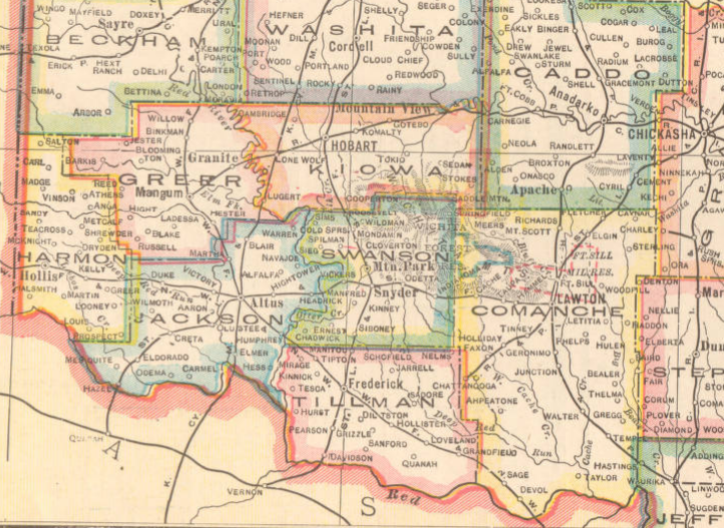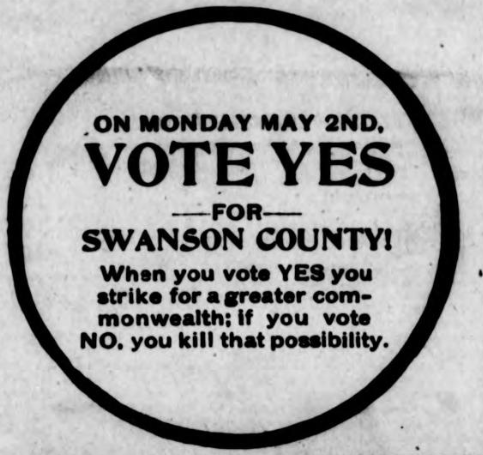Swanson County, Oklahoma's original 77th county
On the back wall of the Meers Store, overlooking a dining table laminated with a poster of Lucille Ball singing the praises of Royal Crown Cola, is a framed map of Oklahoma, a page from an old Geo. F. Cram atlas, circa 1910.

The 1910 map shows several differences with the final form of Oklahoma's county map. Tulsa County looks even more like a collection of unwanted scraps, missing chunks at its southeastern and northeastern corners -- Collinsville, and everything northeast of 126th Street North and Mingo, are in Rogers County; everything southeast of 121st Street and Mingo are in Wagoner County. One of the post-statehood counties is there -- Harmon County (born June 2, 1909) has been carved out Greer County -- but Comanche County's southern boundary is the Red River; Cotton County would not be created until 1912. The map reflects the June 11, 1910, election that moved the state capitol from Guthrie to Oklahoma City.
And yet this map shows 77 counties. In southwestern Oklahoma, between Comanche, Tillman, Kiowa, and Jackson Counties, there is Swanson County, with its seat at Mountain Park. Swanson County included the towns of Snyder, Roosevelt, Cooperton, formerly in Kiowa County, and Indianola, formerly in Comanche County.
You can view a badly-registered four-color version of the Cram 1910 map of Oklahoma in Oklahoma State University's online map collection; the version at the Meers is yellow and black only. Swanson County also appears in Rand McNally's 1911 map of Oklahoma.

Swanson County's existence was brief, tumultuous, and ultimately found to be illegal. A referendum to carve the county out of southern Kiowa County and the westernmost 8-mile-wide band of Comanche County passed on May 2, 1910, with over 60% of the vote (1990 for to 1220 against), but failed to meet that threshold in the section of Comanche County to be included in the new jurisdiction. The portion of Kiowa County voted 1910 to 907 in favor of the new county, while the Comanche County portion voted against by 80 to 223. Gov. Charles Haskell proclaimed the new county's existence on August 13 and designated Mountain Park as the county seat, but the citizens of Snyder, at an important rail crossroads, objected. According to the Encyclopedia of Oklahoma History and Culture:
Competition arose between Snyder and Mountain Park for the seat. Snyder citizens claimed that their town was better suited because Mountain Park lacked a water system, fire protection, and office space for county officials. After dark on September 5, 1910, Snyder citizens removed the records from Mountain Park when a rainstorm soaked the documents housed there. In retaliation, Mountain Park men invaded county officials' homes and arrested the officials at gunpoint. Wyatt L. Staples, who worked for one of the county commissioners, was killed.
The Swanson County Democrat published letters to the county commissioners, one from County Judge Frank P. Cease and one signed by the treasurer, surveyor, registrar of deeds, court clerk, county clerk, district clerk, and superintendent. Judge Cease stated of the county courthouse:
At the present time the building is not in a habitable condition for the safe preserving of the records and the property of the county. It is impossible to remove the filing and record cases to any safe place where they would not be exposed to fire or being carried away, and the roof of the building is in bad condition, and some of the property has already been damaged by reason of the bad condition of the building.
The other county officials complained that Mountain Park "is without sufficient hotel and eating house accomodations to meet the demands of your petitioners [the county officials] or the public at large and that there are no suitable residence or sleeping accomodations for the use of your petitioners and their familes." A news story on the same page reported that officials were forced to stay in Snyder and commute every day to Mountain Park, a distance of four miles each way. The only official that didn't move his office to Snyder was the county sheriff.
A headline in the September 15, 1910, Swanson County Democrat trumpeted:
Snyder Remains County Seat
GOV. HASKELL REFUSES TO ACT
County Officers Remain at Snyder--County Court Held Monday and Tuesday--All Legal Business Transacted Here--No Riots--No Trouble--Just a Lot of Guano Eltoro in the Oklahoman Furnished by L. E. Cahill and E. J. Giddings Attorneys for Mt. Park
Comanche County sued to have the creation of Swanson County nullified. The Supreme Court upheld the district court's decision, citing the language of Article 17, Section 4, of the Oklahoma Constitution: "Provided, that when the territory is to be transferred from an existing county to either a new or an existing county, there must be sixty per centum of the vote cast in such particular territory in favor of the transfer."
Swanson County might have succeeded had it not attempted to include that unwilling chunk of Comanche County. It would have met the requirement for 400 square miles of land, but perhaps it would have fallen short of the required 15,000 population or $2.5 million land valuation.
With the Oklahoma Supreme Court ruling, Swanson County ceased to exist, and the count of Oklahoma counties reverted to 76. Nevertheless, the territory once claimed by Swanson County would continue to elect a representative to the State House for the remainder of the decade, as it existed during the 1911 legislative apportionment, and the Kiowa County representative would elected only by those voters in the remaining part of Kiowa County, according to an Attorney General's opinion reported in the April 11, 1912, edition of the Kiowa County News.
It's easy to understand why residents of southern Kiowa County would want a county seat closer to home. Manitou was, at that time, on the border between Kiowa County and Tillman County. Someone living on the Kiowa County side of Manitou would be 36 miles as the crow flies from the county seat of Hobart, but the Tillman County side was only about 7 miles from the county courthouse in Frederick.
An item in the September 1, 1910, Swanson County Democrat describes "the new county craze which has seized southwestern Oklahoma," mentioning a new effort to form a county out of southern Caddo and northern Comanche County centered on the town of Apache.
On January 30, 1909, a proposal to create Park County, with the same boundaries that would be proposed a year later for Swanson County had fallen short of the 60% threshold by 18 votes, just a month after the southernmost township of Kiowa County had voted to join Tillman County, a decision that still needed to be ratified by the voters of Tillman County.
Not long after the end of Swanson County, a smaller swath of southern Kiowa County succeeded in getting itself transferred to Tillman County, and in 1912, the southern section of Comanche County seceded to form Cotton County, bringing the roll of counties back to 77. There would be a few more boundary adjustments over the coming years, but the end of county creation had come to a close.
0 TrackBacks
Listed below are links to blogs that reference this entry: Swanson County, Oklahoma's original 77th county.
TrackBack URL for this entry: https://www.batesline.com/cgi-bin/mt/mt-tb.cgi/8338